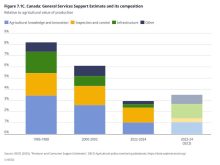The millions of dollars the railways are reported to have overcharged western grain farmers underscores the need to review railway costs – and to update the formula used to determine how much the railways can earn hauling grain.
So said Canadian Wheat Board (CWB) spokeswoman Maureen Fitzhenry in an interview last week: “We need to make sure the revenue cap is set at the right place and to do that we need to have a costing review.”
Last month the Canadian Transportation Agency (CTA) announced both Canadian National Railway (CN) and Canadian Pacific Railway (CPR) exceeded their revenue caps for the 2007-08 crop year by record amounts: $25.96 million and $33.8 million, respectively. That’s almost 10 times previous overages.
Read Also

Finally getting paid for sustainable farming?
Alberta project says they might have a line on a workable ecosystem credit model to reward farmers for sustainability, and Manitoba might be next
In total the railways exceeded their combined caps by $58.8 million. It means farmers, on average, overpaid the railways $2.23 a tonne.
Rail Costing Reviewer /
“It’s definitely good news for research because as we all know there seems to be less and less research dollars out there.”
– Lanette Kuchenski, WGRFW
“We’re getting lots of calls from angry farmers about this,” Fitzhenry said.
The railways have until Jan. 30 to transfer the $58.8 million, plus a 15 per cent penalty ($3.9 million and $5.07 million for CN and CPR, respectively, for a total bill of almost $68 million) to the Western Grains Research Foundation (WGRF).
As in previous years when one or both railways exceeded the caps, the foundation will invest the money and spend the interest on crop research to benefit Prairie farmers.
Past railway overages have, on average, been just pennies a tonne, hitting a high of 12 cents in 2005-06. But with this year’s exceeding $2 a tonne, more farmers are asking why they can’t get their money back, Fitzhenry said.
Never imagined
It isn’t practical and the administration costs would be too high, said WGRF executive director Lanette Kuchenski. The WGRF never imagined it would get so much money this way, she added. When the revenue cap was established everyone expected the railways wouldn’t exceed it.
It could be three to five years before the WGRF gets to use the money, given the railway’s options to appeal the penalties. But if the WGRF gets to keep the money it will be a significant boost, dwarfing the $14 million in its current endowment fund.
“It’s definitely good news for research because as we all know there seems to be less and less research dollars out there,” Kuchenski said. “The federal and provincial governments continue to pull back on actual research dollars to the researchers. Research is expensive and we have to stay competitive with the rest of the world.”
Coincidentally, the railway overage is not far off the $69.8 million by which the CTA cut the rail revenue cap by last February in accordance with federal legislation to reflect what the railways were spending to repair government-owned hopper cars. It turned out that while the revenue cap allowed the railways $4,000 a car per year for maintenance, they were only spending $1,700.
Both railways protested the change, especially the fact that it was made retroactively to the start of the crop year, Aug. 1, 2007. The CTA gave the railways a heads-up in June 2007, when the agency estimated that the change, made official in February 2008, would reduce the cap by about $72 million.
The railways appealed the CTA’s change to the cap, but the Federal Court of Appeal ruled in the CTA’s favour in November. Last week CPR spokeswoman Breanne Feigel said her company is seeking leave from the Supreme Court of Canada to appeal again.
As frustrated as farmers might be by the railways’ apparent defiance, the railways say they had little alternative. Had they adjusted their rates and then later won their appeal regarding the revenue cap adjustment related to hopper cars, they would be out that revenue.
Review wanted
Meantime, the CWB is urging “all grain producers” join the Canadian Federation of Agriculture’s (CFA) call for a full railway costing review. Farmers can send that message to Ottawa through the CFA’s web-site (http://cfa-fca.ca/pages/emailer. php).
The federal government previously set rail freight rates for grain, but stopped in 1996 to encourage greater grain transportation and handling efficiency. However, to reassure farmers fearful a lack of competition between railways would allow them to charge what the market would bear, in 2000 the federal government passed legislation capping the amount the railways can charge for shipping grain.
The formula was based on the last in-depth review of railway costs conducted by the CTA in 1992 and was lowered to reflect recent railway efficacies.
Each year the CTA adjusts the formula for inflation, reflecting higher labour and fuel costs, but increases in railway efficiency are not part of the calculation.
CFA’s and CWB’s suspicions that the cap is higher than it should be was verified by the consultant they and the National Farmers Union, Agricultural Producers of Saskatchewan, Keystone Agricultural Producers and Wild Rose Agricultural Producers hired.
John Edsforth of Travacon estimates the railways are collecting $100 million, or $6 a tonne, too much from grain shippers.
Western Canada’s grain-handling and transportation system should be a lot more efficient now than in 1992. There are fewer rail branch lines and 1,000 fewer elevators and most grain moves in 100-car trains. “Yet farmers aren’t sharing in the benefits of those efficiencies and we think they should,” Fitzhenry said. “If they adjusted the costing used in the revenue cap, it would.”
Fitzhenry stressed the CWB wants the railways to be profitable and able to provide farmers good service, but farmers shouldn’t have to overpay.
The revenue cap exists in the absence of true railway competition and the formula behind it needs to be based on accurate figures, she said. [email protected]















